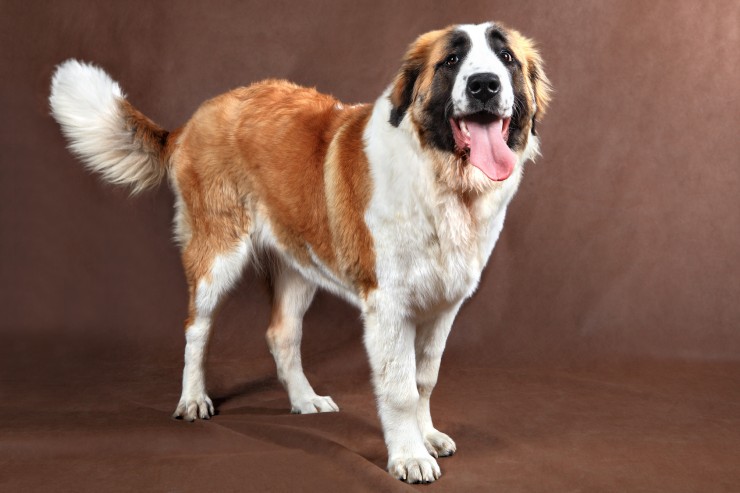

Research recently carried in France established that larger dog breeds often suffer from digestive issues because they are built differently to smaller breeds. It's the size of their intestines along with the length of time food stays in their colons that cause most of the problems. The question is what can owners do to reduce the risk of their pets suffering from digestive issues?
Larger dogs have less intestinal mass which only makes up around 3% of their overall bodyweight whereas in smaller dogs, their intestines make up 7% of their bodyweight. The result is that larger dogs absorb fewer nutrients from food as it passes through their intestines. The food stays in their colons for longer too which means it ferments a lot more and as such more “by-products” are produced. As a result large dogs need to go to the toilet more frequently and their stools are often watery as a result. This can often lead to them suffering minor or sometimes chronic digestive issues which can affect their overall health.
There are ways to help your dog one of which is to feed them a diet that contains higher levels of fibre and ideally this needs to be the sort that will not ferment as much in their colon. There are two main types of fibre, the first being “digestible” and the second being “indigestible”. As their names suggest, indigestible fibre is typically used to bulk out commercially produced dog food and it gets passed out in a dog's stools. However, digestible fibre is used by cells found in a dog's colon lining where it is divided into two forms which are “fermentable” or “non-fermentable”. It is far better for larger dogs to have non-fermentable fibre in their diets, but where commercial dog food is concerned the labels are often a little confusing.
With most commercially produced dog food the labels normally just list the amount of “crude fibre” that's contained in it whether it’s dry or wet food. This makes it hard to know just how much is digestible and what percentage is non-digestible. However, feeding a home-made diet ensures that your dog is given less fermentable fibre which goes a long way in helping to reduce the volume of water produced in the colon. The result is that your dog is far less likely to suffer from any digestive issues and it would help ensure they pass firmer and healthier stools. With this said, if smaller dogs are fed a diet containing less fermentable fibre, the result would be the opposite and they would end up passing harder stools which in a worst case scenario would make them very constipated, something to be avoided at all costs.
It's also very important that larger dogs be fed a diet containing good quality highly digestible protein. The poorer the quality, the less digestible it is which can lead to digestive issues and looser stools. However, the research only compared wheat gluten against chicken meal as protein sources which are more commonly used in commercially produced dog food. In short, the jury is still out as to whether larger dogs would benefit from being fed commercially produced food that contains another form of protein as more research would need to be carried out to establish if this would indeed be the case.
With this said, the studies did suggest that larger dog breeds would benefit from being fed a home-made diet that contains good quality meat-based highly digestible proteins rather than commercially produced food simply because they are far less likely to develop digestive issues if they are. Researchers also discovered that well cooked starches commonly found in food help larger dogs pass firmer stools. However, the fact the food was overcooked or put through very high temperatures when it was processed means that most nutritional value is totally destroyed. In short, it would hold very little to no nutritional value and the result would be an under or malnourished dog.
Recent research shows that larger dogs do have very different nutritional requirements to that of their smaller counterparts. The reason being their intestinal mass is around half of that of small breeds which in turn means they absorb fewer nutrients as food passes through their systems. Larger breeds need less fermentable fibre in their diets and more digestible protein for their stools to be firmer and less watery. The research suggests that commercially produced food does not contain the right sort of fibre or protein and that larger dog breeds do better when fed home-made food that consists of highly digestible meat-based proteins which helps reduce the risk of them suffering digestive issues.
 Why Is My Cat Losing Weight? - The 5 Main Reasons
Why Is My Cat Los
Why Is My Cat Losing Weight? - The 5 Main Reasons
Why Is My Cat Los
 Keeping Your Cat Cool And Comfortable During The Summer
Keeping Your Cat
Keeping Your Cat Cool And Comfortable During The Summer
Keeping Your Cat
 Separating Aggressive Hamsters
Separating Aggres
Separating Aggressive Hamsters
Separating Aggres
 The Importance Of Annual Health Checks For Your Cat
The Importance Of
The Importance Of Annual Health Checks For Your Cat
The Importance Of
 Five Universal Personality Traits Of The English Bulldog
Five Universal Pe
Five Universal Personality Traits Of The English Bulldog
Five Universal Pe
Copyright © 2005-2016 Pet Information All Rights Reserved
Contact us: www162date@outlook.com